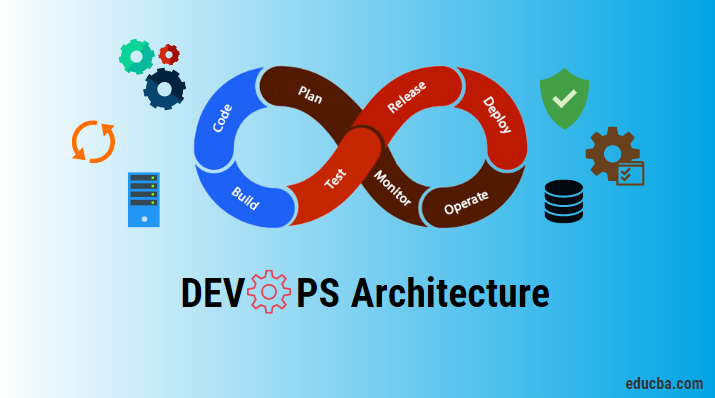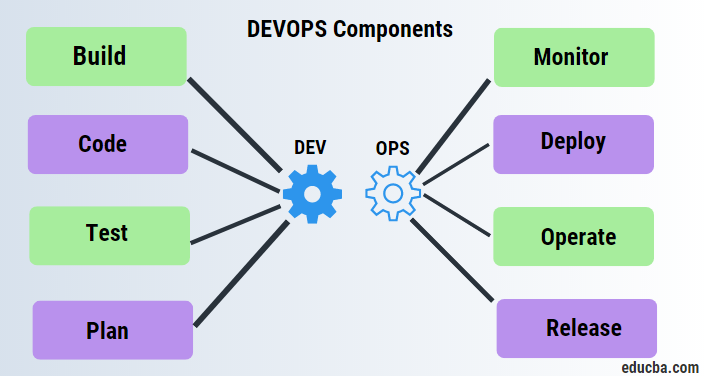Updated May 22, 2023

Introduction to DevOps Architecture
In Software Engineering, Development and Operations are vital in delivering applications. The development comprises analyzing the requirements, designing, developing, and testing software components or frameworks. The operation consists of administrative processes, services, and support for the software. When both Development and Operation collaborate, they combine to form the picture of DevOps architecture. Moreover, it can be gathered that DevOps architecture is the solution to mend the gap between Development and Operations teams so that the delivery can be faster with fewer issues.
DevOps Architecture and Components
Teams use DevOps architecture for hosting applications on cloud platforms and developing large distributed applications. Agile Development is used here so that integration and delivery can be continuous. When the Development and Operations team work separately from each other, it is time-consuming to design, test and deploy. Also, if the teams are not in sync with each other, it may cause a delay in delivery. So DevOps enables the teams to amend their shortcomings and increase productivity.
Below are the various DevOps components
1. Build
The evaluation of the cost of resource consumption was based on pre-defined individual usage with fixed hardware allocation before the adoption of DevOps. But with DevOps, the use of the cloud and sharing of resources comes into the picture, and the build depends upon the user’s need which is a mechanism to control the usage of resources or capacity.
2. Code
Many good practices like widely used git enable the code to be used, which ensures not only writing the code for business but also helps to track changes, getting notified about the reason behind the difference, and, if necessary, reverting to the original code developed. The code can be appropriately arranged in files and folders etc., and they can be reused.
3. Test
The application will move to production after it is tested. In the case of Manual Testing, it consumes more time in testing and pushing the code to display. Automating the testing process reduces the time required for testing, thereby decreasing the time to deploy the code to production. Running automated scripts eliminates many manual steps, making the testing process more efficient.
4. Plan
DevOps use agile methodology to plan development. Unplanned work always reduces productivity. With the Development and Operations teams in sync, it helps organize the work to plan accordingly to increase productivity.
5. Monitor
Continuous monitoring is used to identify any risks of failure. It is also helpful in tracking the system accurately so that the application’s health can be checked. The monitoring becomes easier with services where the log data may be monitored through third-party tools like Splunk.
6. Deploy
Most systems can support the scheduler for automated deployment. A cloud management platform enables users to capture accurate insights and view the optimization scenario and analytics on trends through the deployment of dashboards.
7. Operate
DevOps changes the way the traditional approach of developing and testing separately. The teams operate collaboratively, participating actively throughout the service lifecycle. The operations team interacts with developers and devises a monitoring plan for IT and business requirements.
8. Release
Generally, deployment to an environment can be done by automation. However, the deployment to the production environment is triggered manually. Most of the processes involved in release management commonly specify manually deploying in the production environment to lessen the impact on the customers.
Features of DevOps Architecture
Below are the key features of DevOps Architecture.
1. Automation
Automation most effectively reduces time consumption, specifically during the testing and deployment phase. Since automated tests are executed more rigorously, they increase productivity, accelerate releases, and reduce issues. This will lead to catching bugs sooner so they can be fixed more quickly. The team uses automated tests, cloud-based services, and builds for continuous delivery to implement each code change. This promotes production using automated deploys.
2. Collaboration
The Development and Operations team collaborates as a DevOps team, improving the cultural model as the teams become more effective with their productivity, strengthening accountability and ownership. The teams share their responsibilities and work closely in sync, which in turn makes the deployment to production faster.
3. Integration
To integrate applications with other components in the environment, the integration phase involves integrating the existing code with new functionality, followed by testing. Continuous integration and testing enable continuous development. The frequency of the releases and micro-services leads to significant operational challenges. To overcome such challenges, continuous integration and delivery are implemented to deliver quicker, safer, and more reliable.
4. Configuration Management
This ensures that the application only interacts with the resources concerned with the environment in which it runs. The configuration files separate the external configuration from the source code by creating them outside the application. The configuration file can be written during deployment or loaded at the run time, depending on the environment it is running.
Conclusion
DevOps architecture enables collaboration between teams, one of the essential delivery features. It helps improve the work culture among the teams to remain in sync to understand the work status related to other teams. It helps speed up the release process and enables teams to work more organized by planning and executing work more effectively and efficiently. Many DevOps architecture certifications are available from Amazon, Microsoft, and Red Hat. DevOps architecture effectively decreases the deployment time, making it highly recommended among organizations.
Recommended Articles
We hope that this EDUCBA information on “DevOps Architecture” was beneficial to you. You can view EDUCBA’s recommended articles for more information.


